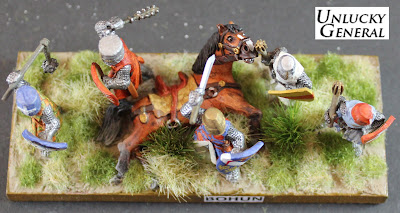Ankerus de Freschville: Research & Modelling
 |
| Azure, a bend between six escallops, argent |
The Freschvilles, like so many baronial families, came to England with William of Normandy in 1066 and by 1200 through marital connections had inherited and established their power base in Stavely, Derbyshire. Of Stavely Manor, Ankerus de Freschville (son of Ralf) was of age when he succeeded to the family estates in February 1261 but we do not know the date of his birth. If of age, then he was at least 21 years so cannot have been born later than 1240.
Ankerus appears to have married twice, firstly to a Joanna (who presumably died) and then married Amice Musard (daughter of Robert) who was a local lady, bringing with her additional, adjacent manors in dowry. Ankerus had significant holdings (Stavely, Woodthorpe, Whitwell, Crich, Bunny and Scarcliff) and with Amice he fathered a son and heir, Ralph (born not before 1265) who was to inherit but does not appear to have been of age at his father’s death – being a ward of Richard de Grey in 1275.
The date of Ankerus’ death is in some dispute. The Colectanea Topographica has it at 1268, other open source genealogical sites have it before the end of 1266 and others in 1270. Richard’s Bygone (An early history of Palterton) has reference of Ankerus making payments under writ for his lands on 12 January 1269 at the Scarsdale wapentake court – so it appears that he died between 1269 and 1275.
He is recorded as having been with the rebels and present at the fall of Northampton where he was and captured and his lands forfeit - possibly placed in the keeping of Brian de Brompton. Under the later ‘Dictum of Kenilworth’ they were returned in accordance with the ‘Dictum of Kenilworth’. The subsequent fines imposed upon the rebel Ankerus must have been significant as we are told that the penalty (calculated at up to five times the value of his estates) was still not paid for by the time of his father’s death. As a result it appears that some of these manors had passed to others – the son paying for the sins of his father.
Ankerus is also placed by some at Chester with the ‘Disinherited’ (May 1266) which would be consistent with his apparent heavy fines, calculated against the level of involvement in the rebellion. Therefore, I surmise that like so many others, he broke parole after Northampton, joined with the Montfortians at Lewes and continued with the ‘Disinherited’ rebellion until at least their defeat at Chesterfield.
Ankerus de Freschville was survived by his heir Ralph and wife Amice.
Modelling: My Ankerus de Freschville is another Mirliton miniature thirteenth century knight. In this case I have gone with a plain surcoat but given him a white cross baronial field sign on the left breast. I have given him a heraldic caparison and I have also altered the figure slightly, giving him a fan crest for his great helm. At this time, he is the most flamboyant of my knights with his crest as I wanted to try something different. I mean, there's always 'one' in every crowd isn't there? The fan is made from green stiff, glued (Araldite) into a grove I filed in the top of the helm. The helmet came with a sculpted crest which I cut away and filed back - thinking it too continental or even Germanic for my 'English' knight. He is based alongside a sergeant with my version of a de Vere livery shield as I have him with my Left Ward knights under the overall command of Robert de Vere.
References:
Richard’s Bygone Times website: An early history of Palterton (1002 to 1700)
Collectanea Topographica et Geneologica (Vols 4) London 1837 (see Google books)




Comments
another very exciting find and story, the research you are digging up is excellent!
keep up the Great Work Greg
cheers
Matt
Thank you,
David de Frescheville